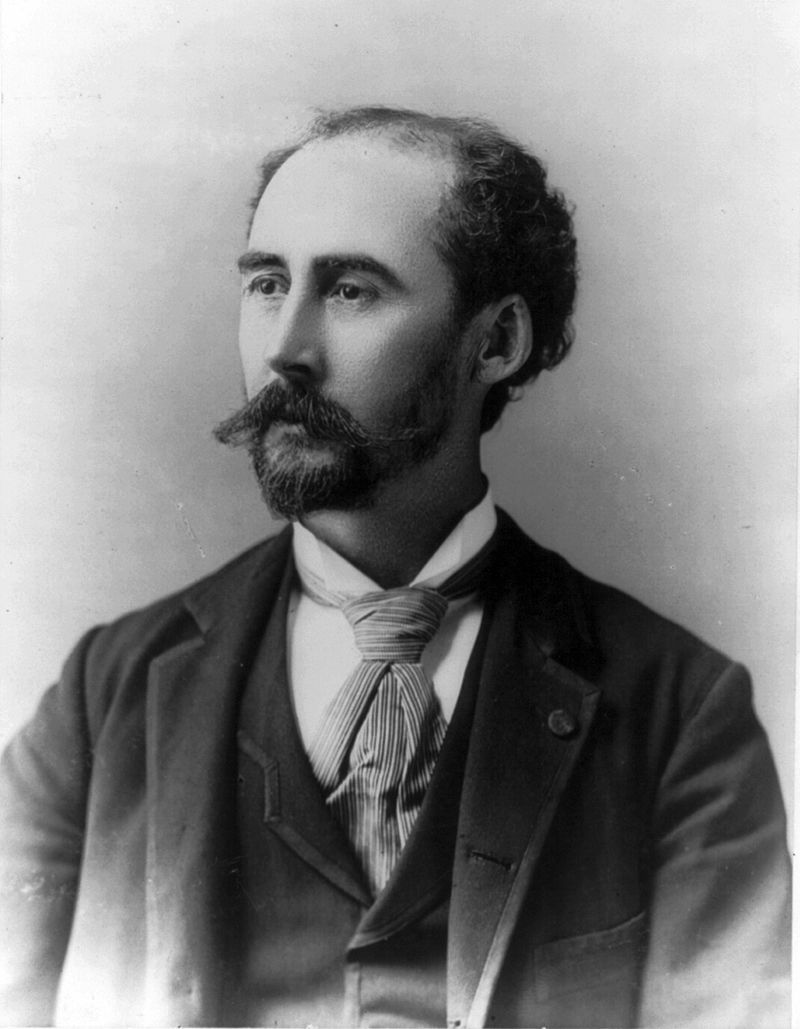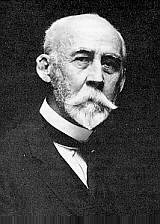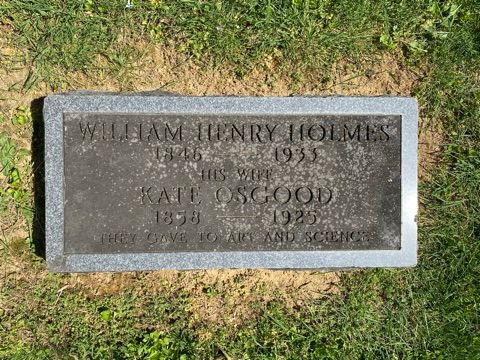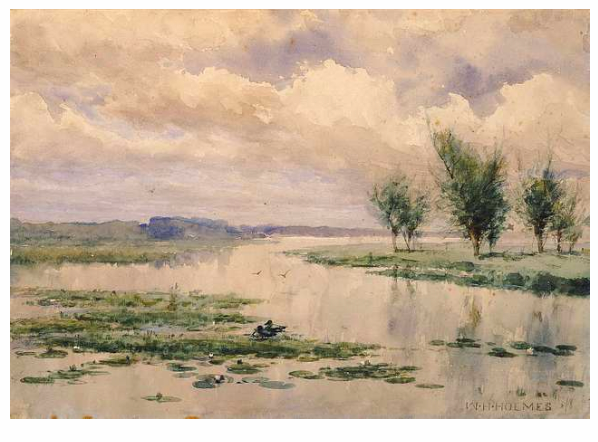CAREER: Artist, geologist, archeologist, anthropologist, ethnologist, and Smithsonian museum director. Born the same year the Smithsonian Institution was founded. One of the "Fathers of modern American archeology."
* 1870-1871, teacher, McNeely Normal School, physical geography, natural history, drawing and painting.
* 1871, contract Illustrator, Smithsonian Institution.
* 1872-1879, Topographical Illustrator, Assistant Geologist, Hayden Survey, under the command of Ferdinand Vandiveer Hayden (including Yellowstone, Territory of Colorado, Arkansas, and Elk Mts.).
• August 1879 to July 1880, William Henry Holmes studied art in Europe with an extended stay at the American art colony in Germany.
• 1880-1889, Geologist with the United States Geological Survey, under Captain Clarence Dutton (Colorado Plateau country, the Grand Canyon of the Colorado).
• 1882, honorary appointment as Curator of Aboriginal Pottery, U.S. National Museum.
• 1889, transferred from the U.S. Geological Survey to the U.S. National Museum, Bureau of American Ethnology.
• 1889-1898, Archeologist, Bureau of American Ethnology. He created the emblem, below, for the Bureau.
• 1893, (afterhours) instructor, The Art Students' League.
• 1894-1897, Curator of Anthropology of the Field Columbian Museum, Chicago, Illinois.
• 1897-1902, Curator of the Department of Anthropology (encompassing ethnology, archeology, technology and history), U.S. National Museum.
• 1902-1909, Chief of the National Museum, Bureau of American Ethnology.
• 1906-1909, temporary Curator, National Gallery of Art, U.S. National Museum.
• 1908, delegate to the First Pan-American Scientific Congress in Santiago, Chile.
* 1909-1920, Curator, National Gallery of Art, U.S. National Museum. AND CONCURRENTLY
• 1910-1920, Curator of the Department of Anthropology, U.S. National Museum (now the Smithsonian Museum of Natural History).
• 1920-1932, first Director of the National Gallery of Art (separated 1920 from the U.S. National Museum, and made a distinct unit of the Smithsonian Institution).
• 30 Jun 1932, retirement following a stroke.
PERSONAL: Oct 1883, married Kate Clifton Osgood. They had two children: William Heberling Holmes and Osgood Holmes. He retired 30 Jun 1932, and died at his son, William's home on 20 Apr 1933 in Royal Oak Charter Township, Oakland Co., Michigan.
SOME OF HIS HONORS:
1876, Member of the Academy of Natural Sciences of Philadelphia.
1889, honorary A.B. degree, McNeely Normal School.
1891, Secretary of Section H, American Association for the Advancement of Science.
1892, Vice-President of Section H, American Association for the Advancement of Science.
1892, appointed non-resident Professor of Anthropic Geology at U. of Chicago.
1897, Honorary Fellow of the Anthropological Institute of Great Britain and Ireland.
1898, Loubat prize, First Place ($1,000) for his work, "Stone Implements of the Potomac-Chesapeake Tidewater Provinces."
1899, Member of the American Philosophical Society of Philadelphia.
1899, Corresponding Member of the American Institute of Architects.
1900, Correspondence Member of the New York Academy of Sciences.
1900, "silver medal for a landscape in water color, 'The Ripple,'" at the Appalachian exposition, Knoxville, Tennessee.
1900-1902, president, National Anthropological Society of Washington, D.C.
1902, honorary title, Curator of Prehistoric Archeology, U.S. National Museum.
1902, Parson's Prize, $50, for the painting "Mountains of the Nevada Desert."
1902, award, Washington Water Color Association exhibition in painting;
1902-1903, a Vice-President of the Washington Society of the Archeological Institute of America (formed in 1902).
1903, appointed Commissioner of the United States on the International Commission of Archeology and Ethnology;
1903, Corresponding member Die Berliner Gesellschaft fur Anthropologie, Ethnologie, and Urgeschichte;
1903, Corresponding Member Svanska Sallskapet fur Anthropologi och Geografi;
1904, Honorary Member, Davenport Academy of Sciences;
1904, Vice-President Fourteenth International Congress of Americanists;
1904-1912, Councilor of the Washington Society of the Archeological Institute of America;
1905, elected member of Academy of Sciences;
1905, elected Member of the American Antiquarian Society;
1907, President, Cosmos Club, which he also helped found;
1909, Vice-President of Section H, American Association for the Advancement of Science;
1909, President, National Society of Fine Arts;
1909, President, American Anthropological Association;
1909, Delegate of the National Academy of Sciences to the Fifteenth Anniversary of the American Institute of Architects;
1910, silver medal, Appalachian Exposition, painting;
1900-1911, 1913, vice-president, Washington Water Color Club;
1914-1928, president, Washington Water Color Association;
1914, chairman, membership committee, Washington Society of the Fine Arts.
1914, member ex officio of the council of the Washington Society of Fine Arts;
1915, Chairman of the Organizing Committee of the Nineteenth International Congress of Americanists and the Pan-American Congress, Acting President of the Congress of Americanists, delegate of the United States to the Pan-American Congress, and Chairman of the Section of Anthropology of the Pan-American Congress;
1916, Corresponding Member Academia Nacional de Historia of the Republic of Columbia;
1916, appointed by President Wilson a Member of the National Research Council;
1916, the "Holmes anniversary volume: anthropological essays" was presented to William Henry Holmes at a dinner in honor of his seventieth birthday;
1917-1918, President of the Washington Academy of Sciences;
1918, Honorary Doctor of Sciences degree from George Washington University;
1919, Life Membership in National Geographic Society;
1922, October 2, dinner in honor of Dr. and Mrs. William H. Holmes;
1922-1923, President, Society of Washington Artists;
1923, second Loubat prize ($400) for his book "Handbook of American Aboriginal Antiquities;"
1926, Honorary Member of the American Institute of Architects;
1926, Honorary Member of the French Alpine Club;
1926, on his eightieth birthday, he was given a bound volume of letters from fellow scientists in various parts of the world.
1928, Honorary President of the Washington Water Color Club (until his death);
1930, Honorary Member of the Washington Academy of Sciences; and
1930, Honorary Member of the Anthropological Society of Washington.
In addition, Mount Holmes in the Henry Mountains, Utah; Mount Holmes in Yellowstone National Park, Wyoming; Holmes Tower in Mancos Canyon, Colorado; and a fossil mussel shell, Unio holmesianus, are named in his honor.
After his death, the anthropologist Walter Hough said of him, "Dr. Holmes was an eminent man of science in whom the various phases of art and science were fused to a degree seldom given in one man."
CAREER: Artist, geologist, archeologist, anthropologist, ethnologist, and Smithsonian museum director. Born the same year the Smithsonian Institution was founded. One of the "Fathers of modern American archeology."
* 1870-1871, teacher, McNeely Normal School, physical geography, natural history, drawing and painting.
* 1871, contract Illustrator, Smithsonian Institution.
* 1872-1879, Topographical Illustrator, Assistant Geologist, Hayden Survey, under the command of Ferdinand Vandiveer Hayden (including Yellowstone, Territory of Colorado, Arkansas, and Elk Mts.).
• August 1879 to July 1880, William Henry Holmes studied art in Europe with an extended stay at the American art colony in Germany.
• 1880-1889, Geologist with the United States Geological Survey, under Captain Clarence Dutton (Colorado Plateau country, the Grand Canyon of the Colorado).
• 1882, honorary appointment as Curator of Aboriginal Pottery, U.S. National Museum.
• 1889, transferred from the U.S. Geological Survey to the U.S. National Museum, Bureau of American Ethnology.
• 1889-1898, Archeologist, Bureau of American Ethnology. He created the emblem, below, for the Bureau.
• 1893, (afterhours) instructor, The Art Students' League.
• 1894-1897, Curator of Anthropology of the Field Columbian Museum, Chicago, Illinois.
• 1897-1902, Curator of the Department of Anthropology (encompassing ethnology, archeology, technology and history), U.S. National Museum.
• 1902-1909, Chief of the National Museum, Bureau of American Ethnology.
• 1906-1909, temporary Curator, National Gallery of Art, U.S. National Museum.
• 1908, delegate to the First Pan-American Scientific Congress in Santiago, Chile.
* 1909-1920, Curator, National Gallery of Art, U.S. National Museum. AND CONCURRENTLY
• 1910-1920, Curator of the Department of Anthropology, U.S. National Museum (now the Smithsonian Museum of Natural History).
• 1920-1932, first Director of the National Gallery of Art (separated 1920 from the U.S. National Museum, and made a distinct unit of the Smithsonian Institution).
• 30 Jun 1932, retirement following a stroke.
PERSONAL: Oct 1883, married Kate Clifton Osgood. They had two children: William Heberling Holmes and Osgood Holmes. He retired 30 Jun 1932, and died at his son, William's home on 20 Apr 1933 in Royal Oak Charter Township, Oakland Co., Michigan.
SOME OF HIS HONORS:
1876, Member of the Academy of Natural Sciences of Philadelphia.
1889, honorary A.B. degree, McNeely Normal School.
1891, Secretary of Section H, American Association for the Advancement of Science.
1892, Vice-President of Section H, American Association for the Advancement of Science.
1892, appointed non-resident Professor of Anthropic Geology at U. of Chicago.
1897, Honorary Fellow of the Anthropological Institute of Great Britain and Ireland.
1898, Loubat prize, First Place ($1,000) for his work, "Stone Implements of the Potomac-Chesapeake Tidewater Provinces."
1899, Member of the American Philosophical Society of Philadelphia.
1899, Corresponding Member of the American Institute of Architects.
1900, Correspondence Member of the New York Academy of Sciences.
1900, "silver medal for a landscape in water color, 'The Ripple,'" at the Appalachian exposition, Knoxville, Tennessee.
1900-1902, president, National Anthropological Society of Washington, D.C.
1902, honorary title, Curator of Prehistoric Archeology, U.S. National Museum.
1902, Parson's Prize, $50, for the painting "Mountains of the Nevada Desert."
1902, award, Washington Water Color Association exhibition in painting;
1902-1903, a Vice-President of the Washington Society of the Archeological Institute of America (formed in 1902).
1903, appointed Commissioner of the United States on the International Commission of Archeology and Ethnology;
1903, Corresponding member Die Berliner Gesellschaft fur Anthropologie, Ethnologie, and Urgeschichte;
1903, Corresponding Member Svanska Sallskapet fur Anthropologi och Geografi;
1904, Honorary Member, Davenport Academy of Sciences;
1904, Vice-President Fourteenth International Congress of Americanists;
1904-1912, Councilor of the Washington Society of the Archeological Institute of America;
1905, elected member of Academy of Sciences;
1905, elected Member of the American Antiquarian Society;
1907, President, Cosmos Club, which he also helped found;
1909, Vice-President of Section H, American Association for the Advancement of Science;
1909, President, National Society of Fine Arts;
1909, President, American Anthropological Association;
1909, Delegate of the National Academy of Sciences to the Fifteenth Anniversary of the American Institute of Architects;
1910, silver medal, Appalachian Exposition, painting;
1900-1911, 1913, vice-president, Washington Water Color Club;
1914-1928, president, Washington Water Color Association;
1914, chairman, membership committee, Washington Society of the Fine Arts.
1914, member ex officio of the council of the Washington Society of Fine Arts;
1915, Chairman of the Organizing Committee of the Nineteenth International Congress of Americanists and the Pan-American Congress, Acting President of the Congress of Americanists, delegate of the United States to the Pan-American Congress, and Chairman of the Section of Anthropology of the Pan-American Congress;
1916, Corresponding Member Academia Nacional de Historia of the Republic of Columbia;
1916, appointed by President Wilson a Member of the National Research Council;
1916, the "Holmes anniversary volume: anthropological essays" was presented to William Henry Holmes at a dinner in honor of his seventieth birthday;
1917-1918, President of the Washington Academy of Sciences;
1918, Honorary Doctor of Sciences degree from George Washington University;
1919, Life Membership in National Geographic Society;
1922, October 2, dinner in honor of Dr. and Mrs. William H. Holmes;
1922-1923, President, Society of Washington Artists;
1923, second Loubat prize ($400) for his book "Handbook of American Aboriginal Antiquities;"
1926, Honorary Member of the American Institute of Architects;
1926, Honorary Member of the French Alpine Club;
1926, on his eightieth birthday, he was given a bound volume of letters from fellow scientists in various parts of the world.
1928, Honorary President of the Washington Water Color Club (until his death);
1930, Honorary Member of the Washington Academy of Sciences; and
1930, Honorary Member of the Anthropological Society of Washington.
In addition, Mount Holmes in the Henry Mountains, Utah; Mount Holmes in Yellowstone National Park, Wyoming; Holmes Tower in Mancos Canyon, Colorado; and a fossil mussel shell, Unio holmesianus, are named in his honor.
After his death, the anthropologist Walter Hough said of him, "Dr. Holmes was an eminent man of science in whom the various phases of art and science were fused to a degree seldom given in one man."
Inscription
WILLIAM HENRY HOLMES 1847 - 1933 His Wife KATE OSGOOD 1958 - 1925 THEY GAVE TO ART AND SCIENCE
Gravesite Details
Also inurned in M-101-7 are his wife, Mrs. Kate Clifton Osgood Holmes, his son, Osgood Holmes, and his mother-in-law, Mrs. Cornelia Adams Upham Osgood.



















